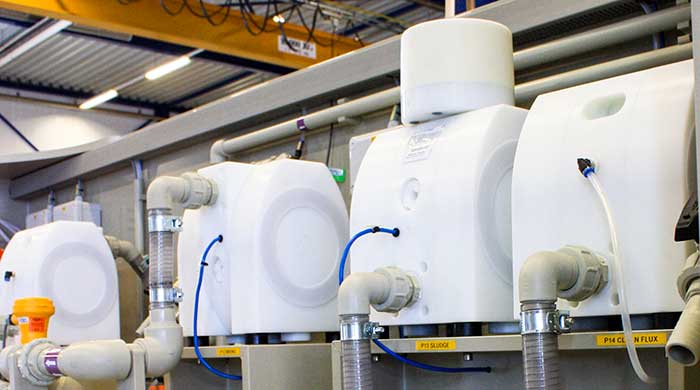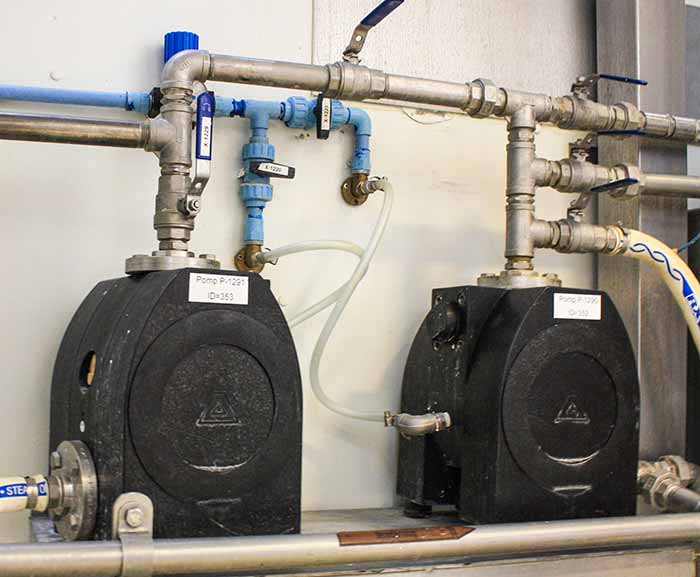Their names sound like sinister creations that would spring from the evil mind of a mad scientist in a futuristic novel or movie: hexafluorochloride, dexamethasone, germanium and cadmium telluride. In reality, they are among the many chemical ingredients that are indispensable foundational components in the manufacture of such commodities as pharmaceuticals, semiconductors and solar panels.
The main concern for the manufacturers of these “high-purity” chemicals is not trying to pronounce their names or remembering how to spell them, but ensuring they are produced in a manner that guarantees the highest level of pureness. When these chemicals are not manufactured according to strict specifications, nightmarish scenarios can result that are worthy of science fiction for the manufacturer and the end user.
This article illustrates how one type of pumping technology—the solid-body plastic, air-operated double diaphragm (AODD) pump—possesses the design, construction and operational characteristics to properly process high-purity chemicals, while offering energy efficiency and safely.
 Image 1. Using plastic solid-body AODD pumps can help ensure high-purity chemicals are fully contained and protected from contamination. (Images courtesy of Almatec)
Image 1. Using plastic solid-body AODD pumps can help ensure high-purity chemicals are fully contained and protected from contamination. (Images courtesy of Almatec)The Challenge
The universal chemical market consists of thousands of products that are used in hundreds of industries. At the most basic level are low-grade chemicals used in making simple plastics or swimming pool cleaners and sanitizers.
Moving up the chemical food chain are the high-purity chemicals. These products are used in precise manufacturing processes where there can be no variance in the makeup of the chemical or slippage in its overall quality.
On top of the need for pristine purity is that these chemicals can be expensive to produce. Therefore, if a batch does not meet expected quality levels, it can cost hundreds of thousands of dollars in lost revenue for the manufacturer—as well as the blemish on the manufacturer’s reputation. Additionally, because of the high stakes involved in the production of high-value commodities, manufacturers will strictly audit the production processes of the chemical companies to make sure the chemical is produced according to established specs. Anything that can cause the chemical to become out-of-spec would be grounds for the end user to consider finding another supplier.
Another concern for chemical manufacturers is that many products can be highly toxic and dangerous to handle. This means that any time high-purity chemicals are handled, there is an inherent risk involved.
The release of these chemicals can lead to severe health consequences for humans and animals, as well as damage to the environment.
Keeping dangerous high-purity chemicals fully contained can be easier said than done.
Since many can also be highly corrosive, the pumping equipment used to transfer them is prone to chemical attack if the materials of construction are not compatible with the acid, caustic or solvent fluid.
Materials of construction are not the only factor to consider when determining if a pump should be used to handle dangerous chemicals. The design features of the pump should also be considered.
If the design incorporates mechanical seals or packing, it may be prone to leaking. Attempts have been made to eliminate the shortcomings of pumps that feature mechanical seals through the implementation of magnetic couplings or double barrier seals. While these methods of containment do outperform mechanical seals, they also possess some disadvantages that reduce their effectiveness.
 Image 2. Plastic solid-body construction AODD pumps eliminate small crevices or cavities. In these crevices liquids can accumulate and leak paths can be created.
Image 2. Plastic solid-body construction AODD pumps eliminate small crevices or cavities. In these crevices liquids can accumulate and leak paths can be created.The viscosity range of liquids that are transferred by pumps with magnetic couplings is limited by the amount of transferable torque that can be created. The use of pumps with double seals or barrier liquids can be impractical because of the possibly elevated level of maintenance required.
Some common pump styles that have traditionally been used to handle high-purity chemicals include lobe, gear and centrifugal models.
Pneumatically driven AODD pumps are another choice. They possess portable design, sealless operation, dry-run and deadhead capabilities, good suction-lift capability, ability to handle a wide product viscosity range, ability to handle small particulates, control without need of a variable frequency drive (VFD), easy grounding, and simple operation, maintenance and repair.
The Solution
Solid-body plastic AODD pumps that are computer numerical control (CNC)-machined can be a reasonable choice for these demanding chemical applications. The CNC-based design enables tight tolerances, reduced vibration, lower risk of leakage, and greater stability and durability. In general, solid-body AODD pumps are strong and have a long life cycle with minimal and easy maintenance.
Solid-body plastic AODD pumps can also be constructed of high-quality materials such as polytetrafluoroethylene (PTFE) that are specifically compatible with the chemicals that are being handled, which can eliminate corrosion and leak concerns.
The overall design and operation of AODD pumps gives them dry-run capability and controllability while they are sealless. Their compressible drive medium permits gentle delivery with attenuated pressure peaks. Also, the footprint is small.
When selecting an AODD pump for chemical processing, consider:
- Solid-body construction: Is the pump CNC-machined from solid blocks of polyethylene (PE) or PTFE? If so, the pump is not prone to leak paths.
- Diaphragm and containment ring: Does it have a stainless-steel containment ring and ring-tightening structure? This creates consistent high-torque compression that pulls the components tightly together and compresses the diaphragm in such a way that a leak-free seal is achieved.
- Integrated diaphragms: Is the diaphragm’s metal core integrated into the interior of the closed diaphragm? Here, the diaphragm discs are not required, which can eliminate common leak points.
- Air control system: A lube-free valve with two moving parts allows the pump to achieve superior flow-rate efficiency and air consumption, which helps lower the cost of operation.
- Material compatibility: Is the housing constructed from PE, PTFE, PE conductive or PTFE conductive? Additional versatility to material compatibility is realized with the availability of EPDM, PTFE/EPDM and NBR diaphragms; ethylene propylene diene monomer (EPDM), PTFE, nitrile rubber (NBR) and stainless steel ball valves; and PTFE cylinder valves. Depending on the combination, USP Class VI, FDA and EC1935 certificates are available.
- Explosive safety: Pumps constructed of PE/PTFE conductive plastics meet the requirements of the ATEX 2014/34/EU directive. They are approved for use in explosive atmospheres or when pumping flammable liquids.
Other options to consider include:
- Barrier-chamber system: Change in the conductivity of the barrier liquid can be detected and signaled to a controller, which triggers an alarm or halts pump operation.
- Pulsation damper: When operating, it removes pulsation from the liquid flow by equalizing the pressure on both sides of the diaphragm, resulting in pulsation-free flow consistency with no shearing.
- Internal drain system: This allows the pump and piping to be drained without being disconnected. This can reduce the amount of cleaning agent and solvent needed, which also reduces environmental pollution.
Conclusion
Admittedly, there is a science fiction “out there” feeling to many of today’s high-purity chemicals with inquisitive minds needed to develop them and find their uses. What is firmly rooted in reality, however, is the need to manufacture and handle them in accordance with a strict set of specifications that cannot be compromised. That is why guaranteeing purity and quality is job No. 1 for manufacturers. Those concerns can be overcome through the use of pumping equipment that has been designed to achieve reliable production of high-purity chemicals.


